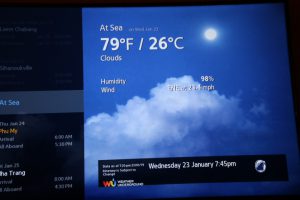Today is a day at sea, accompanied by our latest towel friend.
We travelled overnight across the Gulf of Thailand and at 08:30 a.m. we were off the southwest tip of the enormous Mekong Delta. We were sailing through waters that had entered the gulf from a distributary which has its source near Tibet. This results in a brown sea and the propellers churning the alluvium. This is essentially eroded Southeast Asia!
During the afternoon we were heading northwest passing the Mouths of the Mekong and by tomorrow morning we should be docking in one of these.
We saw some shipping activity: – 3 fishing boats, 2 container ships, 1 barge under tow and at 8:30 p.m. 2 lights on the horizon.
Chinese traders visited this region in the 13th century moving through the South China Sea and the Malacca Strait to the Indian Ocean. Here the spices were traded at ports such as Kochi. Arab dhows, or overland camel trains, moved the valuable cargo onwards. By sea, these spices reached today’s Middle East and then by land to the Mediterranean Sea via Gaza, Aleppo and Istanbul (Byzantium or Constantinople in the past). Overland the commodities crossed Pakistan, Afghanistan ‘the Stans’, Russia and the Caspian Sea ports to Europe.
All of this before European colonialism during the period known as the Age of Discovery in the 16th century. It was only by traders calling in at small ports such as Marseille and Barcelona or by navigating the River Danube from the Black Sea did the spices reach Europe. Safer and faster routes were developed by the Venetians via the Straits of Gibraltar to the Bay of Biscay and even to the Pool of London opposite the 11th century Tower.


